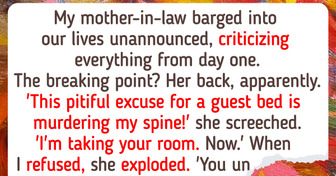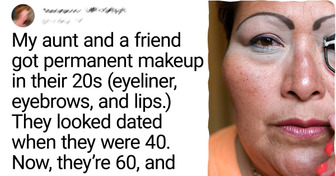My Mother-In-Law’s Outrageous Bedroom Request Forced Me to Take Drastic Action

Many of us read Ivanhoe in our childhood and wanted to live in the same world as the characters — as a brave knight in shiny armor or a beautiful lady in a gorgeous dress. But, as always, the reality was not how we imagined it.
The menu of the nobles during the era of Henry VIII consisted of an insane number of meals, including different kinds of meat, vegetables, exotic fruits, and desserts. People would eat a crazy 5,000 calories a day. But why weren’t they obese?
Well, people used to exert a lot of energy. For example, they needed a lot of energy to keep themselves warm in cold stone castles, to ride horses, and to dance at balls.
Corsets were an irreplaceable part of a woman’s wardrobe for several centuries. In the 16th century, corsets were made from hard materials. Educated male writers often criticized the fact that pregnant ladies wore corsets, because they thought it was bad for babies. But noble women would stick to the habit and continued to wear corsets in public.
Many people know that noble women of the past would take baths wearing shirts. But some took it a step further. For example, Queen Caroline didn’t just bathe in her clothes. The tub itself was also covered with linen sheets to create a sauna effect so that the Queen wouldn’t catch a cold. Her maids would carefully rub her with flannel cloths, using soap and the milk of mares. After that, Caroline would be dressed in a nightgown and put into a warm bed. Some monarchs would even put a bed in the bathroom so as not to get cold after bathing.
In the past, the process of childbirth among noble people was surrounded by a lot of ritual. One of the main jobs of the Queen was to give her husband an heir. So, the health of both spouses, their time spent privately, and their relationship were actively discussed.
During the Tudor era, a little while before labor began, the Queen was supposed to go to her bedchamber and remain there until she gave birth. All the windows in the room, except for one, would be shut. Not a single man would be able to get into the room until the baby was born.
And in France, they had different traditions. The birth of the first child of Marie Antoinette was a show. Aside from the future father, there were a lot of other relatives in the room.
Even in their chambers, the monarchs would never stay alone with each other. In the bedroom, there would always be several courtiers. And the chamber doors would rarely be closed. The first Queen that had a little privacy was Victoria. The monarchs could barely have any secrets from the people around them.
The ladies of the court of Elizabeth I knew all the little details about her female health. And for a high price, they would give this information to the council of the lords, who wanted to be sure the Queen would be able to give birth to heirs.
The canopies above the beds also served a purpose. They not only looked gorgeous, but also protected the monarchs when they were sleeping. The roofs weren’t as safe at the time, and anything could fall on the bed — from trash to bugs.
Before the invention of washing machines and detergents, doing laundry was a very difficult task. But the royal people always valued tidiness. Every monarch had a maid that was responsible for the condition of their clothes.
Most linen clothing was washed. Other outfits were cleaned with a brush and white bread, and the spots were cleaned with natural ingredients. Almost all outfits had a linen layer that would be carefully separated and washed regularly.
The maids knew many of the secrets of the monarchs.
In the Tudor era, the royals often wore linen under their gorgeous clothes. It could be changed several times a day so that their clothes wouldn’t absorb any unpleasant smells.
Their underwear were washed with natural ingredients. And in order to get rid of unpleasant smells, underwear were dried above rosemary and lavender bushes. They made the fabrics smell nice and the sun helped with the rest of the spots.
The royal marriage was a very important event that affected the life of the entire country. Some monarchs were engaged at a very early age. Other kings would choose their wives themselves. Appearance was very important. So, before the engagement, monarchs would ask for a portrait of their potential future wife.
So, Henry VII, the king of England, became interested in Joanna of Naples. But he didn’t have her portrait. So his ambassadors were instructed to provide him with this information: approximate breast size, the freshness of her breath, and whether she had a mustache. The shape of the nose and the condition of her teeth also interested him. Unfortunately, they didn’t get married due to some political and financial reasons.
Starting in the 16th century, shoes with blunt noses became trendy. The soles were made from leather, and the upper layers were made from silk and velvet, decorated with jewelry and embroidered with pearls.
Few people could see ladies’ shoes because of the length of their dresses. But Queen Elizabeth I asked have her skirts cropped, so everyone could see her small feet and slender ankles.
One of the most famous pieces of headwear from the Middle Ages, hennin, is a mandatory attribute of a princess’ carnival costume even today. These cones were made from starched fabrics or hard paper, and covered with silk.
The headwear would stay on their head thanks to the hair inside the cone or thanks to special loops, worn on the ears. In any case, it wasn’t easy to move with this construction on the head. And in the front, there was another loop to hold the hennin when it was windy.
The shape itself came from the East. Mongolian warriors inspired European women to create hennins.
Since ancient times, the royals have been trendsetters. They are the ones who’d create trends and set strict rules. However, in order to wear some of their clothes, women had to be quite agile.
For example, during the Tudor era, there were no single-piece dresses. All of them consisted of separate elements: corsets, parlets, kirtles, farthingales, and others things. All of these items were stitched together or pinned to each other. So, women had to walk very carefully to keep the whole construction in one piece.
Before the wedding of Victoria and Albert, brides would get married wearing dresses in a trendy color. Victoria wanted to make her embroidery more visible, so she chose white. And in order to be at the center of attention, she asked the guests to not wear white. The color quickly became popular, and for almost 2 centuries, women have respected this tradition.
In the 18th century, Marie Antoinette popularized the pouf, a new hairstyle. These high constructions with flowers, models, and jewelry were often mocked in caricatures. And they were really expensive. But women didn’t just have poufs because they were trendy. They were also a way they used to speak their mind about certain things.
So, Marie Antoinette created her own hairstyle to celebrate Louis XVI’s inoculation against Smallpox. At the time, vaccines were considered dangerous. And the Queen spoke her mind about it through her hairstyle. People in France ended up getting vaccines more and more eagerly as the popularity of her hairdo increased.
Hygiene in the late Middle Ages was far from today’s standards and even royal people didn’t take baths very often. So, of course, people would frequently have fleas and use animal stoles. They also used special tubes with holes and sticky substances to make the fleas stick to them.
Also, people used animals themselves to encourage fleas to migrate from them to their pets.
Times have changed, and we can only see knights and queens in movies now. The author of this article adores dresses of the past, but would never trade the comfort we have today for a cold medieval castle. What is your opinion? Share it in the comment section below!











